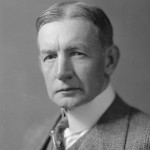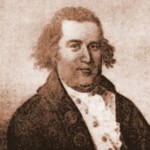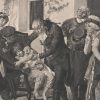Family Tree Tuesday – Charles G. Dawes
Charles G. Dawes was the 30th Vice President of the United States from 1925-1929. He was a co-winner of the Nobel Peace Prize in 1925 for his work on the Dawes Plan for World War I reparations. He served in World War I, was the Comptroller of the Currency, the first director of the Bureau of the Budget, and later the Ambassador to the United Kingdom.
Charles Gates Dawes was born on August 27, 1865 in Marietta, Ohio to Rufus Dawes and Mary Beman Gates. His father was a Brigadier General who commanded the 6th Wisconsin regiment of the Iron Brigade from 1863 to 1864 during the American Civil War. Dawes was the great-great-grandson of the Revolutionary War figure William Dawes. William was one of several men and a woman who alerted colonial minutemen of the approach of British army troops prior to the Battle of Lexington and Concord. Dawes was also the great-great grandson of Rev. Manasseh Cutler who was a member of the United States House of Representatives and the leading person involved with the founding of Ohio University.
His brothers were all prominent businessmen or politicians – Rufus Cutler Dawes, Beman Gates Dawes, and Henry May Dawes. Rufus Cutler Dawes was a businessman in oil and banking, he was appointed by his brother Charles to serve as an expert on the commissions to prepare the Dawes Plan and the Young Plan to manage German reparations to the Allies after World War I in the 1920s. Beman Gates Dawes served two terms as a Republican Congressman from Ohio and later was elected president and chairman of the board of directors of the Pure Oil Company. He founded the Dawes Arboretum, an endowed institution dedicated to the education of youth. Henry May Dawes served as a United States Comptroller of the Currency from 1923 to 1924. During his time as Comptroller with the assistance of a volunteer committee of national bankers, Henry drafted proposals for changes in the banking laws that were submitted to Congress which resulted in the McFadden Act, enacted under his successor.
Did you know that Dawes was a self-taught pianist and composer? His composition, “Melody in A Major” was transformed into the pop song “It’s All in the Game” in 1951 when Carl Sigman added lyrics. Tommy Edwards’ recording of “It’s All in the Game” was a number one hit on the American Billboard record chart for six weeks in the fall of 1958. Dawes is the only Vice-President or winner of the Nobel Peace Prize to be credited with a No. 1 pop hit.
Check out Charles G. Dawes’s family tree and see how you maybe related!









 Genealogy Discussions
Genealogy Discussions Genealogy Projects
Genealogy Projects Popular Genealogy Profiles
Popular Genealogy Profiles Surnames
Surnames The Geni Blog
The Geni Blog The World Family Tree
The World Family Tree